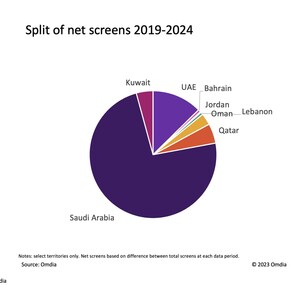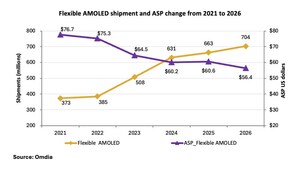LONDON, April 17, 2024 /PRNewswire/ -- Total revenue (including hardware, software and cloud processing) associated with the Virtual Production (VP) market is forecast to reach over $1.1bn in 2028, up from $138.7m in 2023, thanks to widespread use in filmmaking and new use cases in corporate and education settings, according to Omdia's new ProAV Vertical Solutions – Virtual Production 2024 Analysis.
"The prominence of virtual production has grown significantly as more powerful technology has evolved, rapidly improving its effectiveness," said Matthew Rubin, Principal Analyst at Omdia. "Global events such as the COVID-19 pandemic also accelerated adoption, as workflows were forcefully impacted."
Virtual production is a cutting-edge filmmaking technique that seamlessly merges physical and digital elements in real-time, enabling filmmakers to create immersive and dynamic environments on set.
While the benefits of VP for filmmaking are relatively well understood, with obvious and comparable benefits versus green screens, corporate and educational use cases are still evolving. In corporate settings, companies such as SmartStage and Vū are spearheading the use of the technology, with simplified turnkey solutions and subscription to support more effective training, marketing, and collaboration.
Though currently representing a small slice of the wider LED display market, the long-term opportunity for LED vendors is significant, as demand grows from not only major film or TV production studios, but also higher education institutions and the corporate sector, which are set for a CAGR of 130% and 111% for 2023-28 respectively. This is set to boost the value of LED hardware for virtual production from $73.5m in 2023 to $513.2m in 2028.
Early frontrunners in the VP space include LED vendors such as ROE Visual and AOTO (which combined have over half of the market share in 2023 in terms of volume), but with aggressive growth strategies from the likes of InfiLED, Sony, and SiliconCore, among others, the competition is catching up quickly.
Though still at an early stage, AI is likely to be another factor in the coming years, transforming complex VP workflows. This will primarily be achieved through algorithms to optimize rendering, animation, and post-production tasks, improving both efficiency and reducing timelines. In addition, machine learning is aiding predictive analytics for better decision-making during production planning.
The combination of AI, state-of-the-art ProAV technology, managed by the creative industry will drive further opportunity for virtual production from traditional filmmaking into new verticals, effectively creating new markets.
"Vendors not currently involved should look to partnerships in adjacent technology to best position themselves for the coming growth. Developing an understanding of the multitude of technologies and processes in this complex and rapidly evolving market is a vital first step in the virtual production landscape," concludes Rubin.
ABOUT OMDIA:
Omdia, part of Informa Tech, is a technology research and advisory group. Our deep knowledge of tech markets combined with our actionable insights empower organizations to make smart growth decisions.
Fasiha Khan [email protected]
SOURCE Omdia






Share this article